The 1887 Sydney Gold Two Pound Proof Coin - Royalty, Mystery and Scandal
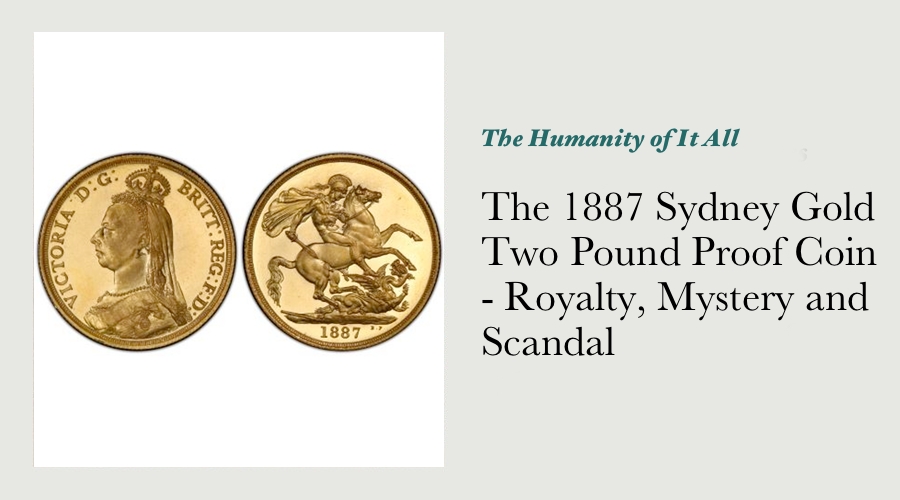
The 1887 Sydney Two Pound Proof is one of Australia’s rarest gold coins. It is in fact so rare that senior staff at the Royal Mint in London were still not aware that it existed until 1922 - more than 3 decades after it was struck.
It has been a highlight of a number of Australia’s finest collections of gold coins - Dangar; Farouk; Dixson and Quartermaster to name but a few, yet despite those provenances, the history of this coin has been presumed and not definitively known. This uncertainty is no doubt grounded in a near-complete absence of official Mint records accounting for its production.
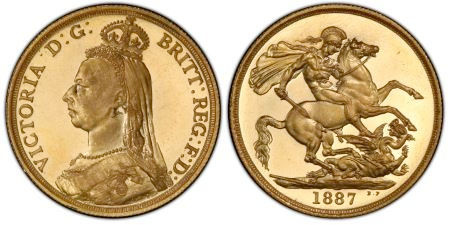
The accepted explanation for the existence of the 1887 Sydney Two Pound is that it was a commemorative struck in 1887 to celebrate Queen Victoria’s Golden Jubilee, and further that it was specifically intended for distribution to VIP’s. Research conducted in the preparation of this article has proven that is not the case.
As several examples of this coin exhibit a proof-like or orange-peel appearance, it has been presumed that two batches of dies were used to strike the 1887 Sydney £2 proof coins, and further that the proof-like coins were re-struck after 1887. Numerous comments have been published that these coins either were or could have been struck in 1893, “in or around 1900”, in 1902 and in 1926. Research conducted in the preparation of this article has proven that none of those dates are correct.
The process of authenticating and attributing these coins is further complicated by the activity of the counterfeiter David Gee. The transcript of the court case against Gee shows that he attempted to strike and pass off several of these coins in the 1970’s. It is of course vital to understand just what technical characteristics these counterfeits have.
This article explains the background to the production of the 1887 Sydney Two Pound Proof coin, explores the technical characteristics of known examples and touches on the characteristics of several of Gee’s counterfeits.
With this new information, collectors can have a clear understanding of where this incredibly rare gold coin sits in the scheme of Australia’s gold coinage, and can have confidence in the characteristics that a genuine example exhibits.
Queen Victoria’s 1887 Golden Jubilee in Sydney - An Outpouring of Royalist and Republican Sentiment
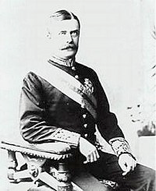 The 50th anniversary of Victoria’s reign was widely celebrated across Great Britain and the Commonwealth. Such was the interest in Britain on this special occasion, the crowd that gathered to view the Royal procession was described by the American writer Mark Twain as “stretched to the limit of sight in both directions.1”
The 50th anniversary of Victoria’s reign was widely celebrated across Great Britain and the Commonwealth. Such was the interest in Britain on this special occasion, the crowd that gathered to view the Royal procession was described by the American writer Mark Twain as “stretched to the limit of sight in both directions.1”
In Britain, the public had such a strong interest in the Jubilee celebrations that “…the gold five-pound pieces were so much in demand that a premium was being paid on some of them.2”
In Australia, despite or perhaps because of the strong public expressions of affection for the monarch, Republican sentiment in New South Wales was at a high point across 1887 and 1888.
A series of boisterous public meetings were held in Sydney in June 1887 to determine how to best congratulate Queen Victoria on her Golden Jubilee.
Clashes on the role of the monarchy in Australia between royalists and republicans continued for several weeks, a newspaper report described one of the meetings as “an absolute chaos of uproar, confusion, faction-fighting and ruffianism of a most disgraceful and unprecedented character in the history of the colony.3”
The “Queen's Jubilee Fund for Distressed Women in New South Wales”, chaired by the Governor’s wife, Lady Cecilia Carrington, was adjudged as being a fitting tribute4 to make to Queen Victoria.
The launch of this fund was planned for the evening of June 15th 1887, in the Sydney Exhibition Building. Either by accident or design, decisions regarding other commemorative events that would celebrate Queen Victoria’s testimonial were held over to the same event.
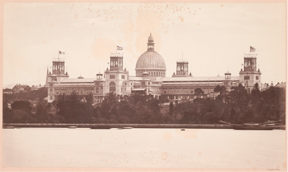 Contemporary newspaper accounts state that 20,000 people attended, and that “In order to secure 'liberty of speech', the police and army and navy reserve, supported by the members of the Loyal Orange Institution, the Primrose League, several football clubs, and the undergraduates of the University, divided the audience of ten thousand inside the building into small, manageable squares. The ten thousand outside were marshalled by a group of mounted police.
Contemporary newspaper accounts state that 20,000 people attended, and that “In order to secure 'liberty of speech', the police and army and navy reserve, supported by the members of the Loyal Orange Institution, the Primrose League, several football clubs, and the undergraduates of the University, divided the audience of ten thousand inside the building into small, manageable squares. The ten thousand outside were marshalled by a group of mounted police.
The platform, defended by a group of undergraduates and footballers, was rushed by the crowd and in the 'hand-to-hand combat' which ensued, a large cedar table and a number of chairs were 'completely smashed, and the fragments scattered far and wide'. The bearers of the banner were forced to beat a hasty retreat. After the uproar had continued for about 20 minutes 'a sudden change came over the scene.5”
Dignity was restored when the Governor and Lady Carrington entered the stage for the motion to found the women’s fund. After they left the building, the crowd resumed their confrontation. The meeting was declared closed at 830pm, and a line of police were used to clear the hall.
No less than 6 days after playing a pivotal role in calming “a demonstration without parallel in the history of Australia6”, Lady Cecilia Carrington helped strike the first Jubilee gold coins at the Sydney Mint.
Although the above events appear to have only a passing relationship to the gold 1887 patterns of the Sydney Mint, they do give us a clear idea of the fundamental role that the Royal Family played in Australian life during this era, and the regard that symbols of the Royal family were held in, at least by the majority of the general public.
An Exclusive Commemorative to Mark Queen Victoria’s Golden Jubilee
The accepted explanation for the existence of the 1887 Sydney Two Pound and Five Pound Proofs is that they were commemoratives struck in 1887 to celebrate Queen Victoria’s Golden Jubilee, and further that they were specifically intended for distribution to VIP’s.
On that basis, one would expect that they were struck prior to June 20th and 21st in 1887 - the exact dates of Victoria’s Jubilee. Mint records do not confirm that. The dies used to strike these coins are not listed among the first Jubilee dies sent to Sydney on April 14th 1887, nor were the coins mentioned in newspaper articles covering the production of the first Jubilee coins at Sydney.
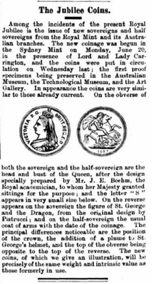 The Australian Town and Country Journal of Saturday 25 June 1887 announced that “Among the incidents of the present Royal Jubilee is the issue of new sovereigns and half sovereigns from the Royal Mint, and its Australian branches. The new coinage was begun in the Sydney Mint on Monday, June 20, in the presence of Lord and Lady Carrington, and the coins were put in circulation Wednesday last, the first proof specimens being preserved in the Australian Museum, the Technological Museum and the Art Gallery.7” The final comment is an interesting anecdote regarding the distribution of the archival coins that were chosen to commemorate the event.
The Australian Town and Country Journal of Saturday 25 June 1887 announced that “Among the incidents of the present Royal Jubilee is the issue of new sovereigns and half sovereigns from the Royal Mint, and its Australian branches. The new coinage was begun in the Sydney Mint on Monday, June 20, in the presence of Lord and Lady Carrington, and the coins were put in circulation Wednesday last, the first proof specimens being preserved in the Australian Museum, the Technological Museum and the Art Gallery.7” The final comment is an interesting anecdote regarding the distribution of the archival coins that were chosen to commemorate the event.
Designing the Jubilee Portrait - A Very Drawn Out Process
The process by which designs for the Jubilee coinage evolved from concept to reality was a very drawn out process, and began in February 1879 when Sir Henry Ponsonby, the Queen's private secretary, informed the Deputy Master of the Royal Mint, Sir Charles Fremantle, “that Boehm had been ordered to execute a new effigy of the queen to serve as the model for future dies.8”
With respect to Boehm’s work on the Jubilee portrait of Queen Victoria, his obituary included the comment that: “Boehm had been greatly hampered by his instructions.9”
Queen Victoria preferred Boehm’s effigy, however unfortunately Royal Mint staff experienced numerous challenges when attempting to translate Boehm’s sculpture into a design that could be effectively used on coinage. These challenges succinctly are expressed in a comment made by Sir William Chandler Roberts-Austen, who was Chemist and Assayer to the Royal Mint between 1882 and 1902: “a coin must be struck at a single blow, & Boehm's design, in plaster, was too high for this to be possible”.10
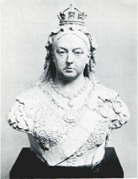 The direct consequence of the drawn out design refinement process is that the time available for the actual production of the Jubilee coinage was quite tight - the Queen did not formally approve Boehm’s portrait until April 1st 1887,11 less than 2 months before the date of her Jubilee.
The direct consequence of the drawn out design refinement process is that the time available for the actual production of the Jubilee coinage was quite tight - the Queen did not formally approve Boehm’s portrait until April 1st 1887,11 less than 2 months before the date of her Jubilee.
Sovereign and half sovereign dies were shipped to the Sydney and Melbourne Mints on April 14th 1887,12 and did not arrive in Sydney until May 31st 1887 - less than 3 weeks before the date of Victoria’s Jubilee.13
Correspondence retrieved from the “Registers of Correspondence” held by the Royal Mint demonstrate that the dies for the 1887 £2 and £5 coins were not dispatched to Sydney until September 30th 1887,14 more than four months after the date of Victoria’s Jubilee celebrations, and were received by Sydney on December 8th 1887. Correspondence retrieved from the Register of Correspondence in the Sydney Mint archives confirms this.
Recent research by the British numismatist David Iverson has shown that Royal Mint staff were under so much pressure in the period leading into Victoria’s Jubilee that it was necessary to hand-finish the obverse dies for the 1887 Sydney Jubilee sovereigns.15 In this context, it is understandable if dies for circulating coinage were a higher priority than those that were not intended for circulation.
The First Batch of Dies - Sunk In A Shipwreck?
One further explanation for the late arrival of the dies is found in a perhaps unlikely source - a book that covered the David Gee legal case in the 1970’s - “Heads I Win”.
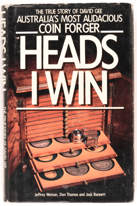 A passage in this book advises that “The dies from which the coins were to be struck were made in the Tower Mint, London, and then shipped to Australia. The vessel carrying them ran into bad weather in that maritime graveyard of last century, the Great Australian Bight, and sank off the South Australian coast. However, the box containing the dies was brought safely ashore and sent on to the waiting Sydney Mint by horseback, wagon and coach. It was a long and harrowing journey across a still wild country, and it was all in vain. When the dies arrived in Sydney they were found to be too badly corroded by their brief immersion in seawater to be used. So a second set of dies was ordered from England.16”
A passage in this book advises that “The dies from which the coins were to be struck were made in the Tower Mint, London, and then shipped to Australia. The vessel carrying them ran into bad weather in that maritime graveyard of last century, the Great Australian Bight, and sank off the South Australian coast. However, the box containing the dies was brought safely ashore and sent on to the waiting Sydney Mint by horseback, wagon and coach. It was a long and harrowing journey across a still wild country, and it was all in vain. When the dies arrived in Sydney they were found to be too badly corroded by their brief immersion in seawater to be used. So a second set of dies was ordered from England.16”
A review of the correspondence registers of the Royal Mint and the Sydney Mint indicates that the author may have used some poetic licence with the available facts.
Although there were perhaps half a dozen shipwrecks recorded off the South Australian coast across 1887, none of them had London as their port of departure.17 Two sections of the Sydney Mint correspondence files retained at the NSW State Archives indicate that something did indeed happen to the dies while they were en route to Sydney - the first correspondence was in December 1887, the second in the mid-1920’s.
Correspondence in 1887 Regarding the Dies
On December 8th 1887, the Deputy Master of the Sydney Mint, Robert Hunt, wrote to the Superintendent of the Royal Mint in London (Charles Fremantle) regarding a parcel of dies that the Sydney Mint had just received. In his letter, Hunt stated that “…regret to have to report that on opening the case the dies were found to be loose and more or less rusty. Nearly all the dies bore marks of friction and one £5 die in particular was much marked.18” No shipwreck or other maritime mishap is mentioned, nor is there any evidence that these £2 and £5 dies dated 1887 were destroyed or repaired after they were received.
Final confirmation that no 1887 £2 proofs were struck by the Sydney Mint in 1887 can be taken from a comment in another letter from Deputy Master Hunt to Sir Charles Fremantle on the same date, where Hunt advises that “We have not as yet struck any £5 or £2 pieces and then await your instructions.19”

Correspondence in the 1920’s Sheds More Light
The second batch of correspondence relevant to the production of the 1887 £2 and £5 dies occurred in the 1920’s. That correspondence was between two British coin collectors; the Deputy Master of the Sydney Mint and the Superintendent of the Royal Mint in London.
Early in 1922, William Hocking, Superintendent of the Royal Mint, received a letter from a stamp and coin dealer based in London, George Hamilton-Smith. Hamilton-Smith was a partner in and Managing Director of Glendining & Co Auctioneers from 1922, and is known to have been a keen collector of coins and medals.20
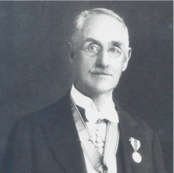 Hocking is noted as the author of “Catalogue Of The Coins, Tokens, Medals, Dies And Seals In The Museum Of The Royal Mint", published by the Royal Mint in 1906. Although Hocking’s book notes that pattern gold coins were struck at the Sydney Mint in 189321 (in itself a remarkable, and wholly unsupported comment), he apparently did not feel that he was in a position to answer Hamilton-Smith’s letter accurately, and he instead directed the question to the Deputy Master of the Sydney Mint, John Campbell.
Hocking is noted as the author of “Catalogue Of The Coins, Tokens, Medals, Dies And Seals In The Museum Of The Royal Mint", published by the Royal Mint in 1906. Although Hocking’s book notes that pattern gold coins were struck at the Sydney Mint in 189321 (in itself a remarkable, and wholly unsupported comment), he apparently did not feel that he was in a position to answer Hamilton-Smith’s letter accurately, and he instead directed the question to the Deputy Master of the Sydney Mint, John Campbell.
Hocking advised Campbell that Hamilton-Smith had stated he owned “sets of Jubilee specimens … bearing your mintmark “S”, and that as the Royal Mint had no records of any such coins being struck, he found that “somewhat disconcerting.22” Hocking pointedly asked Campbell “Have you, in your records, anything which shows that sets were issued by your branch?”23
Campbell wrote responses to both Hamilton-Smith and Hocking several months later. The text of Campbell’s letter to Hocking is as follows:
“With reference to your letter of the 2nd January last I have to state that according to the records of this Branch of the Royal Mint two Five-Pound pieces and twenty-five Two-pound pieces of the “Jubilee” coinage, dated 1887, and having the Mint mark “S”, were issued between the 10th October, 1888 and the 7th December 1892. The name of J.G. Murdoch does not appear in the records and the piece in your possession may possibly have been purchased by him from another collector.”24
Campbell provided Hocking with a copy of his response to Hamilton-Smith, and was somewhat more expansive with details regarding the two coins concerned: “I would supplement this official information for your benefit by letting you know that one Five-pound piece was issued to H.C. Dangar and one to Dr. Evans, both well known collectors, on the 7th December, 1892. Evan’s collection was sold, but I do not know what became of Dangar’s. The Two-pound pieces were issued to sundry persons, one of whom I remember was a hawker travelling the back country, who used to dispose of them on his rounds at a considerable profit, The premium charged was 25 per cent. The dies are still here, as are the dies for the 1893 Five-pound and Two-pound issue.
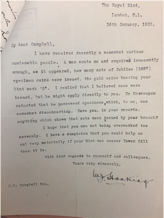 Now here’s a point. It is just possible (You know how things were in 1893) that one or two additional pieces may have been issued in exchange for sovereigns without appearing on the records. There has always been a hazy idea that something of the sort happened, but I have no proof whatever, nor do I know to whom such pieces would be given. You are of course at liberty to supplement the official information given to Hamilton Smith as you may think best.25”
Now here’s a point. It is just possible (You know how things were in 1893) that one or two additional pieces may have been issued in exchange for sovereigns without appearing on the records. There has always been a hazy idea that something of the sort happened, but I have no proof whatever, nor do I know to whom such pieces would be given. You are of course at liberty to supplement the official information given to Hamilton Smith as you may think best.25”
This correspondence gives us a definitive mintage for the 1887 Sydney Two Pound Proof, and also defines the date range over which they were originally struck.
Correspondence ex London Discusses A Second Batch of Dies
No evidence has been found in the correspondence registers of either the Royal Mint or the Sydney Mint of a second parcel of 1887-dated £2 and £5 dies being dispatched to replace those that were “rusty and damaged”. Research into the correspondence registers at the Royal Mint and the Sydney Mint indicates that the second batch of £5 and £2 dies sent to Sydney after September 1887 is that detailed below:
15th November 1887
2 Obv. £5 dies;
2 Rev. £5 “ 1888;
2 Obv. £2 “;
2 Rev. £2 “ 1888
32 Obv. Sov “ ;
32 Rev. Sov “ 188826;
Anyone familiar with Australian gold coins will be aware that this apparently dry and uninteresting manifest is nothing short of remarkable, as it reveals the Sydney Mint had dies for 1888-dated £2 and £5 coins, and that these have never been seen. Just why the 1887-dated dies were apparently used to strike coins once the 1888-dated dies were available is not known.
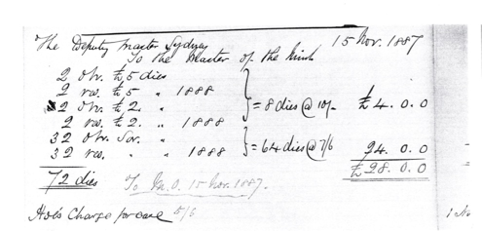 A Review of Existing Literature Covering the 1887 Sydney Two Pound Proof
A Review of Existing Literature Covering the 1887 Sydney Two Pound Proof
The existing written references that cover the production of these coins advise variously that they either were or could have been struck in 1893, “in or around 1900”, in 1902 or 1926. Each of these propositions are reviewed below.
Struck at the Sydney Branch of the Royal Mint in 1887
The earliest discussion of the production of this coin in the public domain can be found in the 1953 auction catalogue by Glendining & Co for the Dangar collection: “Jubilee Two Pound Piece 1887, of similar type to the last, and extremely rare, believed to be only 11 struck. Extremely fine and Probably struck as a proof.27” No official information was cited to support that estimate.
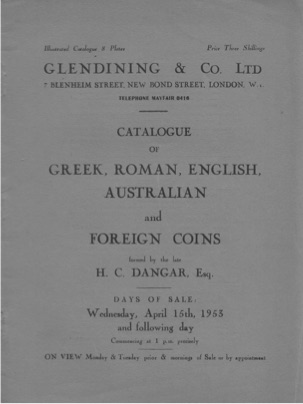 Henry Cary Dangar was a prominent Sydney barrister, politician and sportsman that was active in numismatics from the late 1800’s through to the early 1900’s. His collection has been described as being one of the most important collections of Australian coins formed prior to Federation, and contained numerous Australian and British numismatic rarities. This mintage figure has been repeated several times in various auction lot descriptions by several very experienced numismatists over the years,28 the primary documents that support it are yet to be located.
Henry Cary Dangar was a prominent Sydney barrister, politician and sportsman that was active in numismatics from the late 1800’s through to the early 1900’s. His collection has been described as being one of the most important collections of Australian coins formed prior to Federation, and contained numerous Australian and British numismatic rarities. This mintage figure has been repeated several times in various auction lot descriptions by several very experienced numismatists over the years,28 the primary documents that support it are yet to be located.
Later in 1953, James Hunt Deacon wrote in Volume 4 of the South Australian Numismatic Journal: “Some specimens of the £5 and £2 were struck at the Sydney Branch of the Royal Mint in 1887, bearing the Jubilee Head (Type Vl) and St. George and the Dragon (Type C) (d.w.). There are no records in the Mint Report of that year as to the number of specimens struck and consequently these must be regarded as Bullion. These pieces carry the reference numbers 129 and 130 respectively.29” Hunt Deacon does not cite a primary reference for this conclusion, information in the Correspondence Registers indicates that he was mistaken.
Struck at the Sydney Mint in 1893
An intriguing comment is be found in the “Catalogue of the Coins, Tokens, Medals, Dies and Seals in the Museum of the Royal Mint”, prepared by William Hocking for the Royal Mint in 1906. A note on page 325 of the catalogue states that “Specimen five pound and two pound pieces were struck at the Sydney branch mint in 1893.30” Unfortunately, Hocking does not provide a mintage figure, nor is any explanation given on the circumstances under which the coins were struck, nor were the dates on the reverse dies mentioned.
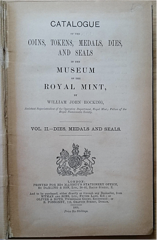 Possibly Struck at the Sydney Mint “Around 1900”
Possibly Struck at the Sydney Mint “Around 1900”
An auction lot description for one Sydney Two Pound proof coin offered for sale in November 1986 contained the following comment “Struck as a semi frosted proof circa 1900. All told, about 10 examples were struck.31" No supporting documentation was referred to in that comment, nor has any been discovered since then.
Struck at the Sydney Mint in 1926?
The former numismatic curator at Museum Victoria, John Sharples, has conducted extensive research into the numismatic collection of Museum Victoria, as well as the collection formed by the former Deputy Master of the Melbourne Mint between 1921 and 1926, Albert Malet Le Souef.
Research into the archival records of the Melbourne Mint by Sharples has shown that Le Souef was instrumental in re-striking the 1887 and 1902 £2 and £5 Sydney proof coins.
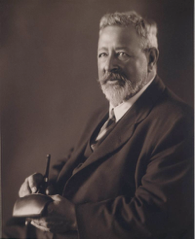 Sharples’ comments on the manufacture of these coins were not intended to be comprehensive, and are presented in the context of articles that are much larger in scope. Although his comments focus more on the 1902 Sydney proof £2 and £5 gold coins, the primary documents that Sharples was working from demonstrate that they apply equally to the same denominations dated 1887.
Sharples’ comments on the manufacture of these coins were not intended to be comprehensive, and are presented in the context of articles that are much larger in scope. Although his comments focus more on the 1902 Sydney proof £2 and £5 gold coins, the primary documents that Sharples was working from demonstrate that they apply equally to the same denominations dated 1887.
In his catalogue of the A.M. Le Souef collection, John Sharples stated that the 1902 Sydney Proof £2 coin was “One of three struck at the closure of the Sydney Mint in 1926. The other two were for Sir William Dixson and the Melbourne Branch of the Royal Mint.32” Sharples stated elsewhere in the same article that just 3 of the 1887 Jubilee Head £2 coins were re-struck in 1926.33
The mintage figures reported by Sharples are confirmed by referring to Melbourne Mint correspondence files between Le Souef and William & Robert Dixson, however the date and location at which those coins were struck may be clarified.
Struck at the Melbourne Mint in 1927
Correspondence between Le Souef and William & Robert Dixson, now housed in the collections of the Museum Victoria and the Dixson Library (in the State Library of NSW) indicates that the coins Sharples refers to were in fact struck at the Melbourne Mint in February 1927, rather than at the Sydney Mint in June 1926.
In a letter dated January 11th 1927, Le Souef wrote to Robert Dixson in Sydney, advising that “Dies were also prepared with a distinctive Mint Mark S. For £5 and £2 pieces of Victoria 1887 and Edward VII 1902. I can strike you one of each of these pieces and hand you the dies lightly defaced by a cut which does not impair the design more than is necessary to prevent the dies being used again.34” Later in the same letter, Le Souef states that 13 pairs of unused sovereign dies were also available for Dixson to purchase, “…and these are very lightly defaced with a fine cut, so that the original polish is left on the surface.35” Le Souef advised that “…the total cost of the above would be £115.36”
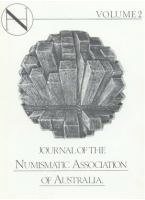 In his work covering the history of the Melbourne Mint, former staff member Bill Mullett has written regarding Le Souef’s proposal that “…the proposition was referred to the London authorities and their concurrence gave some propriety to the matter.37” The correspondence upon which Mullett’s statement is based is yet to be located.
In his work covering the history of the Melbourne Mint, former staff member Bill Mullett has written regarding Le Souef’s proposal that “…the proposition was referred to the London authorities and their concurrence gave some propriety to the matter.37” The correspondence upon which Mullett’s statement is based is yet to be located.
Melbourne Mint correspondence records show that on January 12th, Le Souef wrote to “Mr Green” at the Melbourne Mint, and advised him that “Mr Clucas has a list of the other coins and medals in preparation for Mr Dixson and for the Melbourne Mint collection. If these can be ready on my return on the 24th I will pay for them then and we can send them off with the dies to Sydney. I should however, have to destroy some of the dies before their despatch.38”
Primary documents in Museum Victoria archives shows that these coins were struck at the Melbourne Mint on February 25th 1927, and were then shipped to Robert Dixson in Sydney on February 28th, 1927.39
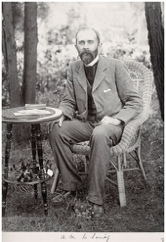 Noticeably absent from Le Souef’s letter to Green were any instructions to repair the dies concerned before they were to be used, which indicates that the re-struck coins should all have the same basic technical characteristics as those struck between 1888 and 1892.
Noticeably absent from Le Souef’s letter to Green were any instructions to repair the dies concerned before they were to be used, which indicates that the re-struck coins should all have the same basic technical characteristics as those struck between 1888 and 1892.
Cross-Referencing Bullion Allocated Against Medals Struck
Melbourne Mint staff recorded the number of each of the 1887 and 1902 £2 and £5 they struck on that date. The reason it appears that the coins Sharples’ has stated were struck in Sydney in 1926 were in fact struck in Melbourne in 1927 is that a minor arithmetical oversight is common to both sets of figures.
The table prepared by Melbourne Mint staff shows a total of 34 “medals” were struck on that date.40 If that production list is cross-referenced against the bullion allocated to the production of those medals,41 we can see that the number of medals struck is short by 1, and that the total number of medals struck from the allocated bullion was in fact 35, rather than 34.
The mintage of the Sydney £2 Proof coins (dated 1887 and 1902) was in fact 6 coins across both dates, rather than 5 as the production list states. One example of each coin dated 1887 and 1902 was struck for Dixson; the Melbourne Mint and Le Souef himself.
This arithmetical discrepancy is also seen in the mintage figures quoted by Sharples, and while it is of course conceivable that Sydney Mint records may yet show that the same number of 1887 and 1902 gold proof coins were also struck at the Sydney Mint in June 1926, such records have not yet been located.
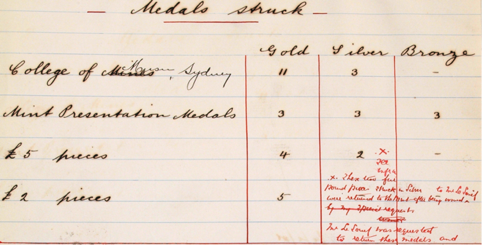
The 1887 Sydney Two Pound proof coin struck for the Melbourne Mint is now housed in the Museum Victoria numismatic collection, while after a somewhat journeyed history, the coin struck for Sir William Dixson remains in the Dixson Library collection within the SLNSW. John Sharples has stated that the example struck for Le Souef was “missing in 1976 stocktake.42” The present location of this coin is not known.
A Further Complication - David Gee and the Dixson Library
An additional factor that must be taken into account when classifying known examples of the 1887 Sydney Two Pound Proof are the activities of David Gee.
For those not familiar with him, David Gee was a Sydney-based coin and stamp collector active in the 1960’s and 1970’s, who was convicted of stealing coins and dies from the State Library of New South Wales, as well as of counterfeiting coins from those stolen dies.43
Over the space of several years, Gee made regular visits to the SLNSW to view coins held by the Dixson collection, and also to take photographs of them. It is understood that the photographs were taken using “…a Box Brownie mounted in a large camera box…”44 SLNSW records indicated that Gee also asked to examine dies from the Dixson collection during this time, the case against Gee was that the coins and dies were smuggled out via the camera box.
The Dies Were Scored Immediately After They Were Used for the Last Time
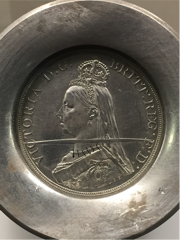
Le Souef’s correspondence with Dixson indicated that the dies were scored shortly after they were used to strike the coins for Dixson, the Melbourne Mint and for Le Souef,45 and before they were dispatched to Sydney on February 28th 1927. Le Souef’s instructions to Green dated January 12th 1927 make no reference to the dies needing any repair or restoration before being put into use.46
This indicates that any of the coins struck at the Melbourne Mint in 1927 should have the same overall technical characteristics as those struck between 1888 and 1892.
On that basis, we can conclude that any coins that show additional die markers to those known to be genuine should be carefully reviewed to determine whether they have been struck by David Gee from the stolen and repaired dies.
Analysis of the technical characteristics of the coins held by the Museum of Victoria and the Dixson collection has determined that they do not show any superfluous die markers. The following points can be noted regarding these coins:
Surfaces: Satin / matte, no frosting is evident in the relief
Strike: Strong - fine details are sharp right across both sides
Obverse die characteristics: 14 pearls in necklace
Reverse die characteristics: No spur in tail; tail points towards lance; BP evident; mintmark above the centre line of the date.
Die Markers for Coins Struck by Gee Using Restored Dies Stolen from the SLNSW
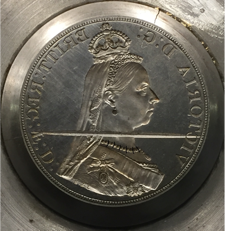 Publicly available images of the 1887 Sydney Five Pound Proof coin dies, published in “Heads I Win”, clearly depict a pair of dies used to strike the 1887 Sydney Gold Five Pounds with a deep score mark across the faces of both dies.
Publicly available images of the 1887 Sydney Five Pound Proof coin dies, published in “Heads I Win”, clearly depict a pair of dies used to strike the 1887 Sydney Gold Five Pounds with a deep score mark across the faces of both dies.
The tradesmen at The Exclusive Diesinking and Engraving Company in Peakhurst that had unwittingly repaired the dies for Gee advised him that “they could not repair his die so that unblemished "fantasy pieces" could be struck from it, but they could make him a new die which would not have the disfiguring score-mark.
After some experimentation that proved unsuccessful, the partners suggested that a process known in the diesinking trade as "hobbing" might do a better job of repairing and reproducing the die.47”
They did not have the appropriate machinery to perform this task, so referred him to another business in Sydney that was able to make a “hob” from the scored die. The raised score line across that “hob” was then removed, and the surface of the hob was repaired to restore the lost design elements. A new die was then created from the repaired hob.
Numismatists acknowledge that the process by which counterfeit coins are manufactured from transfer dies results in a slight loss of fine detail, when the counterfeit coins are compared to coins struck from the original dies.
Die markers that are evident on either the original dies, the counterfeit hob or the counterfeit dies are also seen on the coins that are struck from them.
Several of the 1887 Sydney gold £2 coins counterfeited by David Gee, as well as a counterfeit die and a counterfeit hub that Gee struck are all held in the National Coin Collection (housed at the Royal Australian Mint in Canberra). A physical assessment of them is useful in determining how to identify possible counterfeits.
The National Collection holds three 1887 Sydney gold £2 coins counterfeited by David Gee - the first has been struck from dies created from a genuine London £2 proof that has has a mintmark added to it. The shape of the mintmark on this coin clearly does not confirm with that seen on examples known to be authentic.

The other two counterfeits show very obvious signs of having been struck from the scored dies that Gee stole from the Dixson Library. These coins have uneven surfaces in those sections where the score mark would have been repaired, there are weaknesses in the fine details, and sections of the design have been re-engraved. These characteristics mean these particular Gee counterfeits are very easily identified.
Numismatic Characteristics of Known Examples
The British numismatists David Iverson and Steve Hill have conducted a great deal of research into the Jubilee Head gold sovereigns in recent years48 - the criteria used to demonstrate the evolution in the dies used to strike the 1887 Jubilee sovereigns are useful for the purpose of classifying known examples of the 1887 Sydney Two Pound Proof.
Technical Characteristics of the 1887 Sydney Two Pound ProofSummary of Research Into Correspondence Registers
The research conducted into the correspondence registers of the Royal and Sydney Mints yields the following information:
• No 1887 Sydney Proof gold £2 and £5 coins were struck at the time of Victoria’s Golden Jubilee in June 1887;
• 25 1887 Sydney £2 proofs were struck prior to 1922 ;
• 3 1887 Sydney £2 proofs were struck at the Melbourne Mint in February 1927;
• The dies were damaged before they were first used; and
• £2 dies were prepared for the Sydney Mint dated 1888 and 1893, but were not used.
The 1887 Sydney Gold £2 Proof is unequivocally one of Australia’s rarest and most keenly-sought gold coins.
Although the Sydney Mint struck £5 and £2 gold coins dated 1887 and 1902, as only 2 examples are known in private hands of the 1902 £5; 1902 £2 and 1887 £5, the 1887 Sydney £2 is realistically the only Australian high denomination gold coin that most collectors will have the opportunity to own.
It has a history rich in royalty, mystery and scandal, and has been included in each of the finest collections of Australian gold coins ever formed. It is so rare and exclusive that the Royal Mint in London was not confident it existed more than three decades after it was first struck.
Acknowledgements
My thanks are due to the following people and organisations for their assistance in providing the information found in this article:
David Iverson
Tony Byrne
Dr T. Vince Verheyen
Jim Noble
Matt Curtis and the staff at the Royal Mint Museum (London)
David Berry and the staff at the Dixson Library (SLNSW)
Staff at NSW Archives
Any omissions or errors found in this article are entirely the responsibility of the author.

1 Twain, Mark, “A Tramp Abroad, Following the Equator, Other Travels”, The Library of America, 2010, p 1050.
2 Lant; J.J., "The Jubilee Coinage Of 1887" in the British Numismatic Society Journal, 53, 1973, p 137.
3 Daily Telegraph, Sydney, June 11th 1887, p6.
4 Sear, Margaret, “Femininity that calmed the crowds: Lady Carrington at the queen's jubilee celebrations Sydney 1887”; Journal of Australian Studies Volume 21, Issue 52, 1997, p11.
5 Sear, Margaret, “Femininity that calmed the crowds: Lady Carrington at the queen's jubilee celebrations Sydney 1887”; Journal of Australian Studies Volume 21, Issue 52, 1997, p12.
6 Daily Telegraph, Sydney, June 16th 1887, p5.
7 Australian Town and Country Journal (Sydney), Saturday 25 June 1887, page 30
8 Op. Cit., Boehm, p275
9 The Times Newspaper, London, 13 December 1890, p. 9.
10 Op. Cit., Boehm, p281
11 Op. Cit., Boehm, p280
12 Op. Cit., Iverson I, p6
13 Iverson, David & Hill, Stephen [Ed.], “The Jubilee Head Gold Sovereign 1887-1893”, Baldwin’s, London, 2015, p6.
14 NSW Archives; NRS 13137
15 Ibid, p6
16 Watson, Thomas & Bennett; , "Heads I Win", Angus & Robertson, Sydney, 1986, p 14.
17 https://data.sa.gov.au/data/dataset/shipwrecks
18 NSW Archives, Copies of letters sent [Royal Mint, Sydney Branch], NRS 13138.
19 Royal Mint: Registers of Correspondence; MINT 21
20 https://archive.li/oGJ5Y
21 Hocking; WJ, “Catalogue of the coins, tokens, medals, dies and seals in the museum of the Royal Mint", Royal Mint, London, 1906, p 325.
22 NSW Archives, Copies of letters sent [Royal Mint, Sydney Branch], NRS 13138.
23 NSW Archives, Copies of letters sent [Royal Mint, Sydney Branch], NRS 13138.
24 NSW Archives, Copies of letters sent [Royal Mint, Sydney Branch], NRS 13138.
25 NSW Archives, Copies of letters sent [Royal Mint, Sydney Branch], NRS 13138.
26 Royal Mint: Registers of Correspondence; MINT 21
27 “Catalogue of the important collection of Greek, Roman, English, Australian and foreign gold and silver coins, formed by the late H.C. Dangar”, Glendining, 15 April 1953, p21
28 Fenton; Stephen, "Auction Number 3", St James Auctions, Knightsbridge (London), October 3rd 2005, p Lot 105.
29 Hunt Deacon; James, “Australian Minted Imperial Gold“ in the South Australian Numismatic Journal, Volume 4, 1953, p 30.
30 Hocking; WJ, “Catalogue of the coins, tokens, medals, dies and seals in the museum of the Royal Mint", Royal Mint, London, 1906, p 325.
31 Lot #716, Noble Numismatics Auction 20 (November 1986).
32 Sharples; John, "Catalogue Of Coins, Medals & Checks In The A. M. Le Souef Collection" in the NAA Journal, Volume 2, 1986, p26 (Footnote 4).
33 Sharples; John, "Catalogue Of Coins, Medals & Checks In The A. M. Le Souef Collection" in the NAA Journal, Volume 2, 1986, p26 (Footnote 2).
34 Dixson, William, Sir, 1870-1952. "Sir William Dixson Correspondence and Notes, 1898- 1952."
35 Dixson, William, Sir, 1870-1952. "Sir William Dixson Correspondence and Notes, 1898- 1952."
36 Dixson, William, Sir, 1870-1952. "Sir William Dixson Correspondence and Notes, 1898- 1952."
37 Mullett; WJ, "Melbourne Mint - Branch of the Royal Mint, The Establishment", Self-published, Chifley (ACT), 1992, p 34.
38 Melbourne Mint correspondence
39 Melbourne Mint correspondence
40 Melbourne Mint correspondence
41 Melbourne Mint correspondence
42 Sharples; John, "Catalogue Of Coins, Medals & Checks In The A. M. Le Souef Collection" in the NAA Journal, Volume 2, 1986, p26 (Footnote 2).
43 “Crime that branded our rare coins”, Sydney Morning Herald, March 3, 1979, Page 6.
44 Watson, Thomas & Bennett; , "Heads I Win", Angus & Robertson, Sydney, 1986, p 66.
45 Melbourne Mint correspondence
46 Melbourne Mint correspondence
47 Watson, Thomas & Bennett; , "Heads I Win", Angus & Robertson, Sydney, 1986, p 46-48.
48 Iverson, David & Hill, Stephen [Ed.], “The Jubilee Head Gold Sovereign 1887-1893”, Baldwin’s, London, 2015.